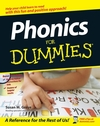

| Book of the Month | ||
 |
Phonics for Dummies |  |
Publisher: Wiley
Author: Susan Greve
US$25.00
ISBN 978-0-470-12764-3
Phonics is a method of teaching reading to young children. It does this by getting them to understand which groups of letters are associated with particular sounds. It is necessary to explain this here, because the author, who has been in the profession for 23 years, seems to assume that everyone knows it, and covers the definition in half a sentence in the introduction. There are a few other times when she assumes that the 'dummies' of the books title have a pretty good grasp of the theory and practice of phonology. (Though fortunately items such as dipthongs are explained, even if briefly.) However, the text itself is fairly heavy going. For instance the section snappily entitled 'Doubling consonants (or not) with suffixes' suggests 'Point to the root word and either show your child that the consonant after the vowel is doubled when the suffix is added or show him that two consonants appear after the vowel.' But it does not add - and this is the place to do it - that the consonant is doubled if the vowel is a short sound, but not if it is a long one. (e.g. 'Hopping' and 'hoping'.) In short, this is not 'Phonics for dummies'; this is phonics for dedicated and intelligent parents or teachers.
There are 356 pages in the book, including an introduction, four appendixes and an index. Confusingly, there are three contents sections, firstly 'Activities at a Glance' followed by one page of 'Contents at a Glance' The activities description takes five pages and gives a detailed description of the 16 chapters of the book. Then, when you are ready to begin, you discover there is also a seven-page 'Contents' listing. Any book that needs sixteen pages and three sections to explain what is in it needs to be approached with caution. The introduction says that four-year-old kids love to look in dictionaries and say things like 'See the schwa! No accent on the syllable!' Some parents might find their children do not, in fact, love to do this. All sixteen chapters have little icons running alongside the text that tell you that the content is a tip, an activity, something to remember or (very often) 'technical stuff'. There is also a CD that comes with the book that helps to explain (for example) what some of the letter groups sound like. This is useful if you are not sure what a schwa-less syllable sounds like.
Who is this book for? Let's be clear. If you really are a dummy, this book will be useful only for starting fires on a cold winter night. If you are a parent who wants to teach a child to read, or an EFL student who wants to improve reading and speaking skills, then this is a book which might help you, but only if you invest a considerable amount of time and effort. On the other hand, you will finish by knowing the difference between (for example) a macron and a breve, which is more than many EFL teachers know.
Verdict: Not for dummies
Assessment 5/10